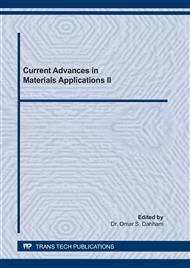[1]
M. Faul, L. Xu, M.M. Wald, V. Coronado, A.M. Dellinger, Traumatic brain injury in the United States: national estimates of prevalence and incidence, Inj. Prev.16 A268 (2002-2006).
DOI: 10.1136/ip.2010.029215.951
Google Scholar
[2]
G.T. Fallenstein, V.D. Hulce, J.W. Melvin, Dynamic Mechanical Properties of Human Brain Tissue, J. Biomech. 2 (1969) 217-226.
DOI: 10.1016/0021-9290(69)90079-7
Google Scholar
[3]
J.E. Galford, J.H. McElhaney, A viscoelastic study of scalp, brain, and dura, J. Biomech. 3 (1970) 211-221.
DOI: 10.1016/0021-9290(70)90007-2
Google Scholar
[4]
E.H. Clayton, G.M. Genin, P.V. Bayly, Transmission, attenuation and reflection of shear waves in the human brain, J R Soc Interface. 9 (2012) 2899-2910.
DOI: 10.1098/rsif.2012.0325
Google Scholar
[5]
J. Zhang, M.A. Green, R. Sinkus, L.E. Bilston, Viscoelastic properties of human cerebellum using magnetic resonance elastography, J. Biomech. 44 (2011) 1909-1913.
DOI: 10.1016/j.jbiomech.2011.04.034
Google Scholar
[6]
M.A. Green, L.E. Bilston, R. Sinkus, In vivo brain viscoelastic properties measured by magnetic resonance elastography, NMR Biomed. 21 (2008) 755-764.
DOI: 10.1002/nbm.1254
Google Scholar
[7]
S.A. Kruse, G.H. Rose, K.J. Glaser, A. Manduca, J.P. Felmlee, C.R. Jack, R.L. Ehman, Magnetic resonance elastography of the brain, J. Neuroimaging. 39 (2008) 231-237.
DOI: 10.1016/j.neuroimage.2007.08.030
Google Scholar
[8]
G.A. Khalid, H. Bakhtiarydavijani, W.R. Whittington, R. Prabhu, M.D. Jones, Material Response Characterization of Three Poly Jet Printed Materials Used in a High Fidelity Human Infant Skull, Mater. Today: Proc. 20 (2020) 408-413.
DOI: 10.1016/j.matpr.2019.09.156
Google Scholar
[9]
M. Jones, G.A. Khalid, D. Darwall, R. Prabhu, A. Kemp, J.O. Arthurs, P. Theobald., Development and Validation of a Physical Model to Investigate the Biomechanics of Infant Head Impact, Forensic Sci. Int. 276 (2017) 111-119.
DOI: 10.1016/j.forsciint.2017.03.025
Google Scholar
[10]
G.A. Khalid, R.K. Prabhu, J.O. Arthurs, M.D. Jones, A Coupled Physical-Computational Methodology for The Investigation of Short Fall, Related Infant Head Impact Injury, Forensic Sci. Int. 300 (2019) 170-186.
DOI: 10.1016/j.forsciint.2019.04.034
Google Scholar
[11]
F. Zhu, C Wagner, A. Dal Cengio Leonardi, X. Jin, P. VandeVord., C. Chou, K.H. Yang, A.I. King, Using a gel/plastic surrogate to study the biomechanical response of the head under air shock loading: a combined experimenta l and numerical investigation, Biomech. Model. Mechanobiol. 11(2012) 341-353.
DOI: 10.1007/s10237-011-0314-2
Google Scholar
[12]
D.W. Brands, P.H. Bovendeerd, G.W. Peters, J.S. Wismans, M.H. Paas, J.L. Van Bree, Comparison of the dynamic behavior of brain tissue and two model materials, SAE Technical Paper. 99SC21 (1999).
DOI: 10.4271/99sc21
Google Scholar
[13]
S.S. Margulies, L.E. Thibault, T.A. Gennarelli, Physical model simulations of brain injury in the primate, J. Biomech.23(1990) 823-836.
DOI: 10.1016/0021-9290(90)90029-3
Google Scholar
[14]
A.E. Forte, S. Galvan, F. Manieri, F.R. Baena, D., Dini, A composite hydrogel for brain tissue phantoms, Mater. Des.112 (2016) 227-238.
DOI: 10.1016/j.matdes.2016.09.063
Google Scholar
[15]
K. Thibault, S. Margulies, Age-dependent material properties of the porcine cerebrum: effect on pediatric inertial head injury criteria, J. Biomech.31(1998) 1119-1126.
DOI: 10.1016/s0021-9290(98)00122-5
Google Scholar
[16]
S.S. Margulies, M.T. Prange, Regional, directional, and age-dependent properties of the brain undergoing large deformation, J. Biomech. 124 (2002) 244-252.
DOI: 10.1115/1.1449907
Google Scholar
[17]
B. Rashid, M. Destrade, M.D. Gilchrist, Mechanical characterization of brain tissue in compression at dynamic strain rates, J. Mech. Behav. Biomed. Mater. 10 (2012) 23-38.
DOI: 10.1016/j.jmbbm.2012.01.022
Google Scholar
[18]
S. Chatelin, J. Vappou, S. Roth, J.S. Raul, R. Willinger, Towards child versus adult brain mechanical properties, J. Mech. Behav. Biomed. Mater. 6 (2012) 166-173.
DOI: 10.1016/j.jmbbm.2011.09.013
Google Scholar
[19]
C. Macosko, Rheology Principles, Measurements and Applications. first ed., New York.
Google Scholar
[20]
A. Hill, Rheeology Basic: Introducing The Malern Kinexus a Practical Measurement Perspective, Malvern Instruments Ltd., 2013. Information on http://www.atascientific.com.au.
Google Scholar
[21]
Laerd Statistics, One-way ANOVA in SPSS Statistics, (2013a). Information on https://www.statistics.laerd.com/spss-tutorials/one-way-anova-using-spss-statistics.php.
DOI: 10.4135/9781506335254.n6
Google Scholar
[22]
A. Smith, C. Grandin, T. Duprez, F. Mataigne, G. Cosnard, Whole brain quantitative CBF and CBV measurements using MRI bolus tracking: Comparison of methodologies, Magn. Reson. Med. 43(2000) 559-564.
DOI: 10.1002/(sici)1522-2594(200004)43:4<559::aid-mrm10>3.0.co;2-n
Google Scholar


